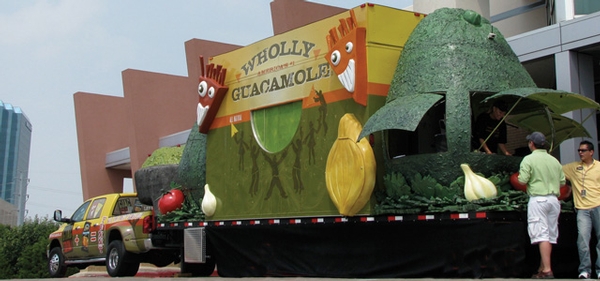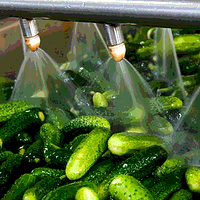Fresherized Foods: Success Under Pressure

The marriage of time and pressure can produce beautiful things. Pure carbon turns to diamonds. Vibrating air particles in the form of variable-speed compressed wavelengths become music to our ears. And pressurized water is helping to make a number of food and beverage products both safer and tastier. Of course, unlike the eons-old pure physics that create gems or sound, the physics of producing safer high-quality foods through high hydrostatic pressure is based on scientific knowledge that is a mere 100 years old—and a technology that has only been commercially available to the food industry for two decades.
In fact, the growth rate of food companies adopting high pressure processing (HPP) shows a steady upward trend in just the last 10 years. One factor driving this growth is that HPP has emerged as a triplethreat technology: It inactivates harmful microbes in foods, preserves and enhances natural flavors, colors and other quality attributes, and extends product shelf life significantly—all without heat, chemicals or preservatives.
But perhaps the most dynamic catalyst in HPP’s growth spurt is a Texas restaurateur named Don Bowden, whose quest for a better way to preserve avocado has revolutionized the adoption and application of the technology in the food industry.
Bowden’s Fort Worth-based company Fresherized Foods is not only the largest HPP user among the world’s food processors but the first to bring the technology to commercialization in the U.S. and its biggest proponent. You might say he ministered the wedding of a diamond-in-the- rough technology to the beat of key food industry quality and safety trends, setting a striking example of how to achieve success under pressure.
The Pressure’s On (In a Good Way)
Don Bowden’s three popular Mexican restaurant chains had been dishing up a classic home-style guacamole for around 37 years when the energetic entrepreneur decided to search out a fresh, all-natural, high-quality, year-round and consistent- cost avocado supply for his restaurants. "Good" guac was simply not good enough for Bowden’s menus. It had to be great.
But the go-getter Texas restauranteur faced a few obstacles when it came to the creamy green dip’s main ingredient, avocado. First, he needed a year-round supply of high-quality avocado. Another issue involved the common preservation method at the time, citric acid, which unfortunately produced a noticeable off-flavor when applied to the sensitive fruit and carried over into the finished guacamole. In addition to the supply and flavor issues, Bowden knew that as an unprocessed or minimally processed ready-to-eat (RTE) food, avocado ranked a higher potential risk for microbial contamination, particularly from foodborne illness-causing pathogens such as Listeria and Salmonella.
Bowden looked to Mexico and found a grower who could supply high-quality Hass avocados year-round. One problem solved. Next problem: How to maintain the safety and preserve the quality of the product? According to Steve Parnell, president of Fresherized Foods, Bowden’s own high standards and the pressure he placed on himself to overcome the challenges of supplying his restaurants with the ideal chip-and-snack dip drove him to investigate the solutions that science had to offer.
"When Don started look at better ways to preserve the fresh avocado from Mexico, he tried to find a technology that would preserve the fresh, all-natural flavor of the fruit," says Parnell. "He was not willing to add citric acid or apply any treatment or process that would degrade the delicate flavor of avocado. As a successful restaurateur, Don knew the importance of having that fresh, authentic avocado flavor to make guacamole. He also knew that he had to fix the food safety issue before he ever brought it across the border."
Bowden dug in and researched various heat pasteurization methods but they damaged or destroyed the quality attributes of the food. He also looked at placing avocados in containers full of vegetable oil as a preservation method but this required an oil draining step after the lot reached its location. Then, in 1993 consultant Phil Waugh steered Bowden toward experts involved with a promising new nonthermal pasteurization technology being tested for food safety and quality applications.
"Don had an opportunity to test a HPP machine in Columbus, Ohio," says Parnell. "The sample was less than a pound but the amazing fresh taste of the treated product after just one test was all it took for Don to say, ’Aha! This is it. This is absolutely, positively what I need.’ He immediately set out to buy any HPP equipment that he could get his hands on for his new food processing company, Avomex, which is now Fresherized Foods. That’s how good that small sample of avocado was."
Bowden secured the first machine, a small system that could treat up to 20 pounds at a time, in the mid-1990s. When the equipment didn’t run consistently, he called the manufacturer to report the problem. When asked about his operational procedures, Bowden told the company that he was running the machine 24/7 making guacamole. "They said, you don’t understand, it is not designed to run 24/7. It is for lab testing only!"
This didn’t stop Bowden from buying the first industrial machine, made by ABB Sweden, sight unseen. He paid for it cash in advance and waited to take to delivery on it until 1996. Parnell says, "And once he had that 50-liter machine, he was off to the races. From that point forward his only concern was buying more equipment because he could sell everything he could high pressure treat."
By the time Bowden actually received the machine, Flow International (now Avure Technologies, Kent, WA) had purchased ABB Sweden’s HPP division. This marriage of Flow’s high pressure pump expertise and ABB Sweden’s pressure vessel expertise resulted in Bowden’s immediate offer to buy the next machine they built. The 215-liter machine arrived in 1999, again purchased sight unseen (as were the seven that followed). His company’s continued collaboration with Avure and other processing experts in developing and refining the technology.
At the same time, Bowden and Waugh collaborated with researchers at the National Center for Food Safety and Technology, Illinois Institute of Technology (NCFST/IIT), where the technology was validated and processing parameters were valuated to ensure correct pathogen kill.
Did You Taste That?
The company’s initial two HPP treated products were guacamole with spice added aimed at the retail market and straight pulp for foodservice operators who could add their own ingredients to create a signature guac. The rate of sales to local retailers and foodservice customers was phenomenal, says Parnell, because "these products were just so great and natural, they had just never seen fresh product like this. They had only seen the acidified product frozen, so Don had no issues selling the product."
Parnell should know. As a division head at the national grocery chain Albertson’s at the time, he was one of Bowden’s first customers. "I was in the retail business for almost 20 years on the merchandising side of fresh produce business. Don came to sell me when I was at Albertson’s. He brings another salesman, who starts giving his pitch but Don stops him and says, ’Steve, just try it,’ and I did. He asked if I liked it, had I ever tasted anything like it? And I said, ’Yes it’s great,’ and he said, ’Well, are you going to buy it or not?’ The sales guy didn’t get another word in."
"We agreed that he would demo the guacamole in all 150 of our stores," says Parnell." Both of us knew that if you could get someone to taste it you’d have a customer. We knew that we had to overcome that stigma of the acidified flavor because anyone who’d ever had a guacamole prepared in a grocery store had that bad experience. So his key to success was not only the technology but also letting people taste it."
 Marcia Walker, Ph.D., Fresherized Foods’ vice president of food technology and microbiology, agrees. "Plus, the HPP treatment provided a food safety benefit without all the chemicals and preservatives that had traditionally been used to attain it. So whether it may or may not have been transparent to the retail customer, it was a product like no other they had seen before because you couldn’t make that same product without the high pressure. Without the high pressure technology you had to add acids, preservatives or chemicals and then the ’bad taste’ issue resurfaced, so quality and safety are really wrapped into each other."
Marcia Walker, Ph.D., Fresherized Foods’ vice president of food technology and microbiology, agrees. "Plus, the HPP treatment provided a food safety benefit without all the chemicals and preservatives that had traditionally been used to attain it. So whether it may or may not have been transparent to the retail customer, it was a product like no other they had seen before because you couldn’t make that same product without the high pressure. Without the high pressure technology you had to add acids, preservatives or chemicals and then the ’bad taste’ issue resurfaced, so quality and safety are really wrapped into each other."
Says Parnell, "Of course, for us the food safety benefit is paramount and for this reason we don’t process anything without HPP. Our customers receive the benefit of that qualifier—that we provide safe, great-tasting products. But to be honest, there is an assumption on the part of consumers that we as a food manufacturer are going to provide them with the safest product possible. And it is our responsibility to do that. So we sell on flavor and food safety. Ultimately it’s the total package— fresh-tasting, all natural, clean label products that have some extended shelf life and are safe."
Powered by HPP: Plants, Process and Product
Today, family-owned Fresherized Foods operates four processing facilities, two in Mexico, one in Lima, Peru and another currently under construction in Chile, which produce HPP treated products for retail, big-box and foodservice establishments in more than 11,000 U.S. locations. The company’s most established product lines are the popular Wholly Guacamole brand Classic, Spicy Guacamole, Guaca-Salsa and Pico de Gallo Style items and 16- pound cases of Fresherized Avocado, Chunky Avocado and Halves for foodservice and select private label customers.
Fresherized Foods’ newest product extensions are the Wholly Guacamole Organic Line and 100-calorie snack packs. More recently, the manufacturer introduced the Dancing Iguana line of salsas and guacamoles. The company also sells avocado pulp to restaurants so chefs can put their own signature twists on the gourmet guacamole products they make.
The largest plant is located in Mexico, where 1,400 employees process nearly one million pounds of guacamole and fresh avocado pulp per week using seven HPP machines. "It’s a very labor-intensive process," explains Parnell. " Fresh avocados come in, get ripened, scooped and blended with spices or without as the case may be. The product is packaged, high pressure treated and shipped—all on a daily basis.
"We were the first plant in the world to process fresh avocados year-round and high pressure technology allowed us to do this," he continues. "Traditionally, avocado processors would process the product when it was cheap, freeze it and shut the plant down during the high season. In Mexico, avocado is a year-round crop which gives us an edge with the fresh factor. So, beyond the food safety assurance and beyond the ability to produce fresh, flavorful product, HPP also gives us the ability to produce a product with a 30-day shelf life that has a year-round demand."
The second south-of-the-border facility processes private label and co-pack red and green salsas, both conventional and organic, as well as organic avocado products. Walker notes that the HPP post-packaging treatment on the salsa is especially advantageous from a food safety perspective, since typical added ingredients like onion, garlic and cilantro present their own microbial risks. "Not only do you get the pathogen kill but you also get the extended shelf life without adding preservatives like sodium benzoate, which you can really taste in a final product, and you retain the fresh, crisp flavor of the salsa," she says.
The company opened a facility in Lima, Peru in early 2008. The plant processes avocado products using a 300L HPP machine made by NC Hyperbaric of Spain. The Santiago plant, scheduled to begin production this fall, will utilize a 300L HPP machine. The location also boasts the company’s latest equipment acquisition, the first-ever 350-liter Fresher Under Pressure system from Avure that features a horizontal orientation designed to make system installation and relocation more feasible.
Fresherized Foods’ central distribution center is located in Fort Worth. Avocado products received from the Mexican plants are distributed from this location to every single customer, every single week, adds Parnell. "With any process or technology that gives you extended shelf life, you still have to get your product to the customer. A big part of our success—and Don’s foresight—is that we are going to go to every customer every week with no minimums. We receive orders, process the product the next day and ship it across the border the next. Everything is made to order and our customers receive fresh product every week. So distribution of fresh, safe, innovative product is key. A product can be all of those things but if you can’t get it to the customers when they need it, it isn’t going to work."
A Technology Comes of Age
Since its successful commercialization in the 1990s—thanks in large part to Bowden and company—the industry has learned a lot about the benefits of high pressure processing in certain food sector applications. As Parnell notes, "You’ve got to marry this technology with the right products to get the right results—not everything is an avocado."
In the past 10 years, HPP has been successfully applied to inactivate microbes, enhance flavor and texture profiles and extend shelf life in a variety of heat-sensitive liquid and solid foods, including guacamole, jams and jellies, fruit juices and smoothies, tomato salsas and sauces, salads and applesauce. HPP has also been successfully applied to ready-to-cook ham, cooked RTE beef and poultry products and high-value seafood such as oysters and lobster.
Essentially, high pressure kills microorganisms by interrupting their cellular functions without the use of heat, which can damage the taste, texture and nutrition of the food. An automated high pressure processing system involves placing the packaged product into a handling basket that is then set into a cylindrical vessel in which ultra-high hydrostatic pressure of between 80,000-130,000 psi is uniformly applied to both pre- and post-packaged foods. Food samples are pressurized for 2 to 10 minutes, depending on the product composition, and then taken out of the chamber and stored or distributed as usual.
HPP will kill most vegetative microorganisms that grow in foods under normal storage conditions. Because the process acts instantaneously and uniformly throughout a mass of food independent of size, shape and food composition, the treated food retains its shape and texture despite undergoing extreme pressure.
Studies show that HPP is particularly effective when applied to high-acid content foods to extend shelf life or improve food safety. Low-acid products that are meant to be shelf stable, such as vegetables or soups, are not good candidates for the process due to HPP’s inability to kill spores without added heat. Low-acid refrigerated products fare better when processed with high pressure, both in terms of extended shelf life and pathogen reduction. For foods where thermal pasteurization is not an option (due to flavor, texture or color changes) HPP can extend the shelf life by two- to threefold over a nonpasteurized counterpart.
Walker notes that HPP has come a long way in a short time. "This is no longer an ’emerging’ nonthermal pasteurization technology," she says. "It has emerged. HPP is accepted as an effective food safety intervention method by both USDA and FDA.
"Of course, on any given product, the log kill depends on the product treated and the specific pathogen targeted. For example, to meet the postlethality interventions regulations for RTE meats, USDA’s Food Safety and Inspection Service required us to show a 2-log microbial reduction and we showed a 5- to 6-log reduction for Listeria. We get at least a 5-log reduction for avocado and RTE meats. The regulations actually list HPP as a means of achieving Alternative 1 status, and that’s quite a distance for a new technology to travel in just a few years’ time."
Innovation Evolution
"We are very fortunate that the avocado market has grown at such a high rate," Parnell says. "The US now consumes over a billion pounds of avocado a year. The growth of such a healthy, green, great-tasting product is phenomenal and we are fortunate to be involved in a category that has a tremendous amount of upside. What’s cool about HPP is that there are so many potential applications of the process, we find ourselves trying to stay focused on the categories we’ve established to grow our core business."
Fresherized Foods’ larger focus remains its commitment to advancing HPP technology and applications through information sharing with industry at scientific conferences all over the world and actively collaborating with stakeholders and experts in the field. "From early on, Don Bowden personally took it upon himself to sell the HPP process to anyone who might benefit from it, whether the benefit was food safety assurance, quality or shelf life," Parnell says. "He is the gutsiest, bravest guy I know, and it takes that kind of entrepreneur to successfully break this kind of technology commercially. In that spirit, our goal is to continue to make a difference in the food safety and quality assurance field whenever the opportunity arises."
Julie Larson Bricher previously served as the editorial director of Food Safety Magazine. She can be contacted via email at julie@quidditycommunications.com.
Looking for a reprint of this article?
From high-res PDFs to custom plaques, order your copy today!






